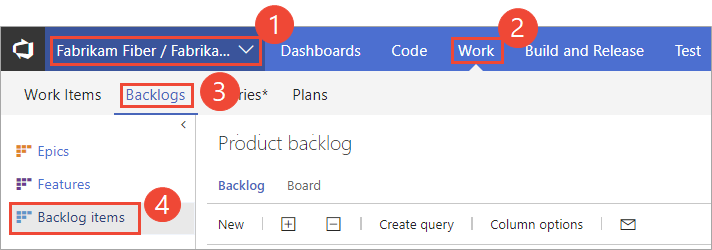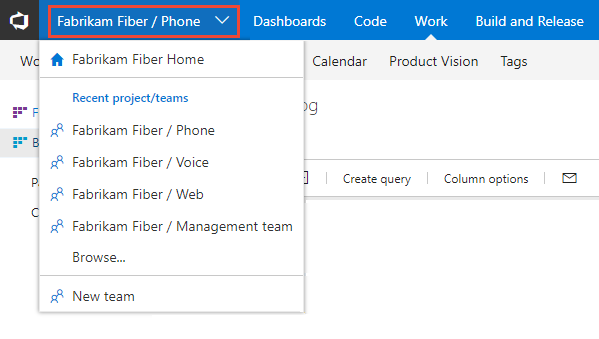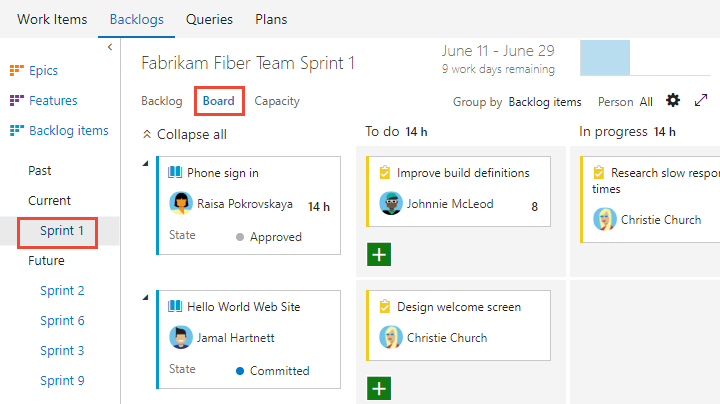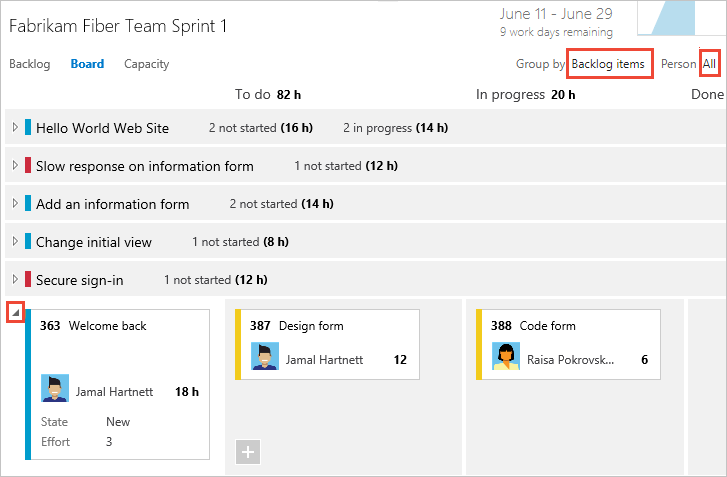6. Update and monitor your Taskboard
TFS 2017 | TFS 2015 | TFS 2013
Once you have your sprint plan in place, you'll execute that plan during the sprint. In your daily Scrum meetings, your team can view progress made to backlog items and tasks from the sprint Taskboard.
Your Taskboard provides a visualization of flow and status of each sprint task. With it, you can focus on the status of backlog items and work assigned to each team member. It also summarizes the total amount of Remaining Work to complete for a task and within a column.
In this article you'll learn how to:
- Open the sprint Taskboard for your team
- Customize your Taskboard
- Use your Taskboard to review progress during daily scrum meetings
- Filter and group work items on your Taskboard
- Update the status of tasks through drag-and-drop
- Update remaining work
- Close out a sprint
If you haven't yet added tasks to your sprint backlog, do that now.
Note
Your Taskboard is one of two types of boards available to you. For an overview of the features supported on each backlog and board, see Backlogs, boards, and plans.
Prerequisites
- Connect to a project. If you don't have a project yet, create one.
- Get added to a project as a member of the Contributors or Project Administrators security group. To get added, Add users to a project or team.
- To add work items and exercise all board features, you must be granted Basic access or higher. Users granted Stakeholder accesses have limited access to features. For details, see Stakeholder access quick reference.
- To view or modify work items, you must have your View work items in this node and Edit work items in this node permissions set to Allow. By default, the Contributors group has this permission set. To learn more, see Set permissions and access for work tracking.
Note
Users with Stakeholder access can't exercise these Taskboard features: add tasks, update fields displayed on cards, drag-and-drop tasks to update status, or use the Planning pane to change the sprint assignment.
Open the sprint Taskboard for your team
From your web browser, open your team's product backlog. (1) Select the team from the project/team selector, choose (2) Work, (3) Backlogs, and then (4) the product backlog, which is Backlog items (for Scrum), Stories (for Agile), or Requirements (for CMMI).

To choose another team, open the project/team selector and select a different team or choose the Browse option.

The set of sprints selected for your team appears in the left pane. If you don't see any sprints listed, you can add sprints or select existing sprints for your team's use. To learn how, see Define sprints.
Choose the sprint you want to plan, and then choose Board.

The system lists only those sprints that have been selected for the current team focus. If you don't see the sprints you want listed, then see Define iteration (sprint) paths.
Customize the Taskboard
Each team can customize their Taskboard in the following ways:
- Customize cards that appear on the Taskboard to show other fields.
- Show bugs on the Taskboard. Your team can choose to manage bugs similar to product backlog items, as shown in this article, or manage them similar to tasks. When you track bugs similar to tasks, they'll show up on your sprint backlogs and Taskboards at the same level as tasks.
Unlike the Kanban board for a product backlog, you can't add another columns to the Taskboard via a team configuration setting. Instead, you need to modify the workflow definitions for the task work item type used by the project. Workflow customizations update the columns for the Taskboard for all teams within the project.
An administrator can customize the Taskboard for all teams in the following ways:
Review progress in daily scrum meetings
During your daily Scrum, you can filter your Taskboard to help focus on items of interest.
- Group by Backlog items or Group by stories to monitor progress of your product backlog items, stories, requirements, or bugs.
- Group by People when you want to monitor progress of individual team members.
Use the Person filter when you want to focus on work assigned to individual team members.
Tip
If you're seeing tasks that don't belong to your team, check that you've selected the correct team.
Show progress on items
With this view, you can quickly see which items are nearing completion and which have yet to be started.
You can expand ![]() and collapse
and collapse ![]() a row to focus on a particular item and its tasks.
a row to focus on a particular item and its tasks.

Show a team member's progress
With this view, you can focus on the work completed and the work remaining for each individual team member. You can quickly see who may need help with completing their sprint tasks. This view shows items and tasks assigned to the selected team member.
Choose the Group by People option, and then select a specific team member, or All.

Group tasks by team members
With this view, you can quickly see all the tasks associated with each team member. Backlog items don't appear in this view, only the tasks associated with each individual.
Choose the Group by People option, and then select a specific team member, or All.

Update tasks during the sprint cycle
The Taskboard makes quick work of updating both task status and remaining work.
Update a task's status
Drag tasks to a downstream column to reflect if they are in progress or completed.

When you move a task to the Done or Completed column, the system automatically updates the Remaining Work field to 0 in all processes, except CMMI. If you discover more work is remaining, change the State back to In progress or To do, and enter a value for the Remaining Work.
Update Remaining Work
Updating Remaining Work, preferably before the daily Scrum meeting, helps the team stay informed of the progress being made. It also ensures a smoother burndown chart.
Each team member can review the tasks they've worked on and estimate the work remaining. If they've discovered that it's taking longer than expected to complete, they should increase the Remaining Work for the task. Remaining Work should always reflect exactly how much work the team member estimates is remaining to complete the task.

Close out a sprint and update your Taskboard
At the end of the sprint, you'll want to complete these final tasks:
- Zero out Remaining Work of all completed tasks
- Update the status of all completed backlog items
- Drag incomplete backlog items and tasks to the next sprint or back to the product backlog.
Drag an incomplete item to the product backlog or to a future sprint updates the Iteration Path of all unfinished child tasks to correspond to the product-backlog iteration path or future sprint.
You can drag-and-drop work items onto a sprint from any backlog or board.
Next step
Work with sprint burndown charts to monitor progress, manage scope creep, and mitigate risks.
Related articles
As you can see, the Taskboard provides support for your Scrum activities. For related articles, see:
- Assign backlog items to a sprint
- Interactively filter backlogs, boards, queries, and plans
- Scrum best practices
- Sprint planning
- Schedule sprints
- Customize a sprint Taskboard
- Capacity planning
Reduce the number of items on the taskboard
If you exceed the number of items allowed on your taskboard, you'll receive a message indicating that you need to reduce the number of items. The maximum number of items includes work item types included in the Requirement and Task categories.
You can reduce the number of items on the taskboard by moving them to the backlog or another sprint. When you move a parent PBI or user story, all active child tasks (State not equal to Done or Closed) automatically move with the parent item.
- From the taskboard, drag the PBI or user story from the first column onto the backlog or future sprint. All child tasks automatically move with the parent item.
- From the sprint backlog, multi-select the items to move and then select the context menu for an item. Then, select the iteration to move them to.

Or, you can increase the maximum number of allowed items.